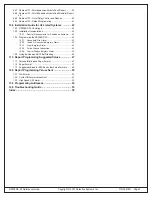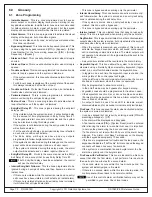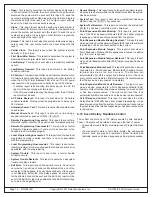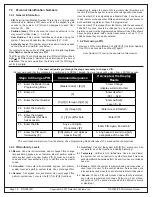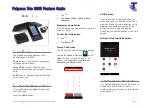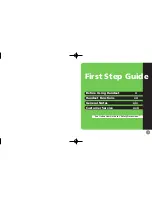
DS7080iP-32 Reference Guide Copyright © 2001 Detection Systems, Inc. P/N 39818D Page 5
2.2
Install the Control/Communicator
The control is static sensitive. Make sure you touch
earth ground before handling the control. This will
discharge any static electricity in your body. Example:
Run the ground wire to the enclosure before handling
the control. Then keep holding the ground wire while
installing the control.
• Insert the three support posts into the control retainer holes as
shown in the diagram.
• Slide the top of the control into the retainer tabs (the slots under
the top frame).
• Once in the retainer tabs, the control will rest on the three support
posts.
• Secure the bottom of the enclosure by screwing the bottom three
holes through the support posts and through to the control retainer
holes.
Once the control is installed, be sure to connect its
ground wire to the top hinge of the enclosure (the
unpainted tab).
1.12 Standby Current Load
Rechargeable
Battery Size
4 AH
7 AH
8 AH
14 AH
15 AH
17.2 AH
Derated
2.825
AH
5.225
AH
6.025
AH
10.825
AH
11.625
AH
13.385
AH
Max. Standby
for 4 hours
590 mA
1.0 A
1.0 A
1.0 A
1.0 A
1.0 A
Max. Standby
for 8 hours
230 mA
530 mA
640 mA
1.0 A
1.0 A
1.0 A
Max. Standby
for 24 hours
X
100 mA
130 mA
330 mA
360 mA
440 mA
Max. Standby
for 48 hours
X
X
X
X
120 mA
160 mA
Max. Standby
for 60 hours
X
X
X
X
X
100 mA
Battery AH - (20% S 0.375 AH’s Alarm)
The following table is the derated battery divided by hours minus the control standby (150 mA):
2.0
Enclosure Installation
The DS7080iP-32 control/communicator and the enclosure are
shipped together. The control, however, still needs to be installed
into the enclosure. Hardware for mounting the enclosure to a wall,
and the control to the enclosure is located in its own hardware pack.
2.1
Install the Enclosure
• Use the enclosure as a template and mark the top mounting holes
on the mounting surface.
• Pre-start the mounting screws for these two holes. Slide the
enclosure onto these mounting screws so that the screws move
up into the thinner section of the holes. Tighten the screws.
• Screw in the remaining two screws in either set of bottom mounting
holes.
• Knock out the desired wire entrances on the enclosure.
• Use knock out bushings if conduit is not used.



